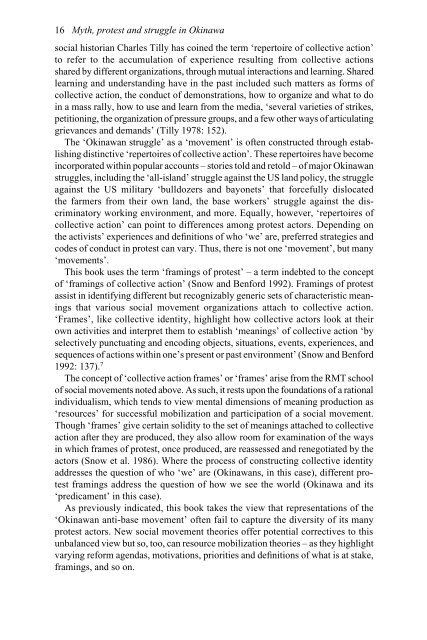Myth, Protest and Struggle in Okinawa
Myth, Protest and Struggle in Okinawa
Myth, Protest and Struggle in Okinawa
Create successful ePaper yourself
Turn your PDF publications into a flip-book with our unique Google optimized e-Paper software.
16 <strong>Myth</strong>, protest <strong>and</strong> struggle <strong>in</strong> Ok<strong>in</strong>awa<br />
social historian Charles Tilly has co<strong>in</strong>ed the term ‘repertoire of collective action’<br />
to refer to the accumulation of experience result<strong>in</strong>g from collective actions<br />
shared by different organizations, through mutual <strong>in</strong>teractions <strong>and</strong> learn<strong>in</strong>g. Shared<br />
learn<strong>in</strong>g <strong>and</strong> underst<strong>and</strong><strong>in</strong>g have <strong>in</strong> the past <strong>in</strong>cluded such matters as forms of<br />
collective action, the conduct of demonstrations, how to organize <strong>and</strong> what to do<br />
<strong>in</strong> a mass rally, how to use <strong>and</strong> learn from the media, ‘several varieties of strikes,<br />
petition<strong>in</strong>g, the organization of pressure groups, <strong>and</strong> a few other ways of articulat<strong>in</strong>g<br />
grievances <strong>and</strong> dem<strong>and</strong>s’ (Tilly 1978: 152).<br />
The ‘Ok<strong>in</strong>awan struggle’ as a ‘movement’ is often constructed through establish<strong>in</strong>g<br />
dist<strong>in</strong>ctive ‘repertoires of collective action’. These repertoires have become<br />
<strong>in</strong>corporated with<strong>in</strong> popular accounts – stories told <strong>and</strong> retold – of major Ok<strong>in</strong>awan<br />
struggles, <strong>in</strong>clud<strong>in</strong>g the ‘all-isl<strong>and</strong>’ struggle aga<strong>in</strong>st the US l<strong>and</strong> policy, the struggle<br />
aga<strong>in</strong>st the US military ‘bulldozers <strong>and</strong> bayonets’ that forcefully dislocated<br />
the farmers from their own l<strong>and</strong>, the base workers’ struggle aga<strong>in</strong>st the discrim<strong>in</strong>atory<br />
work<strong>in</strong>g environment, <strong>and</strong> more. Equally, however, ‘repertoires of<br />
collective action’ can po<strong>in</strong>t to differences among protest actors. Depend<strong>in</strong>g on<br />
the activists’ experiences <strong>and</strong> def<strong>in</strong>itions of who ‘we’ are, preferred strategies <strong>and</strong><br />
codes of conduct <strong>in</strong> protest can vary. Thus, there is not one ‘movement’, but many<br />
‘movements’.<br />
This book uses the term ‘fram<strong>in</strong>gs of protest’ – a term <strong>in</strong>debted to the concept<br />
of ‘fram<strong>in</strong>gs of collective action’ (Snow <strong>and</strong> Benford 1992). Fram<strong>in</strong>gs of protest<br />
assist <strong>in</strong> identify<strong>in</strong>g different but recognizably generic sets of characteristic mean<strong>in</strong>gs<br />
that various social movement organizations attach to collective action.<br />
‘Frames’, like collective identity, highlight how collective actors look at their<br />
own activities <strong>and</strong> <strong>in</strong>terpret them to establish ‘mean<strong>in</strong>gs’ of collective action ‘by<br />
selectively punctuat<strong>in</strong>g <strong>and</strong> encod<strong>in</strong>g objects, situations, events, experiences, <strong>and</strong><br />
sequences of actions with<strong>in</strong> one’s present or past environment’ (Snow <strong>and</strong> Benford<br />
1992: 137). 7<br />
The concept of ‘collective action frames’ or ‘frames’ arise from the RMT school<br />
of social movements noted above. As such, it rests upon the foundations of a rational<br />
<strong>in</strong>dividualism, which tends to view mental dimensions of mean<strong>in</strong>g production as<br />
‘resources’ for successful mobilization <strong>and</strong> participation of a social movement.<br />
Though ‘frames’ give certa<strong>in</strong> solidity to the set of mean<strong>in</strong>gs attached to collective<br />
action after they are produced, they also allow room for exam<strong>in</strong>ation of the ways<br />
<strong>in</strong> which frames of protest, once produced, are reassessed <strong>and</strong> renegotiated by the<br />
actors (Snow et al. 1986). Where the process of construct<strong>in</strong>g collective identity<br />
addresses the question of who ‘we’ are (Ok<strong>in</strong>awans, <strong>in</strong> this case), different protest<br />
fram<strong>in</strong>gs address the question of how we see the world (Ok<strong>in</strong>awa <strong>and</strong> its<br />
‘predicament’ <strong>in</strong> this case).<br />
As previously <strong>in</strong>dicated, this book takes the view that representations of the<br />
‘Ok<strong>in</strong>awan anti-base movement’ often fail to capture the diversity of its many<br />
protest actors. New social movement theories offer potential correctives to this<br />
unbalanced view but so, too, can resource mobilization theories – as they highlight<br />
vary<strong>in</strong>g reform agendas, motivations, priorities <strong>and</strong> def<strong>in</strong>itions of what is at stake,<br />
fram<strong>in</strong>gs, <strong>and</strong> so on.
















